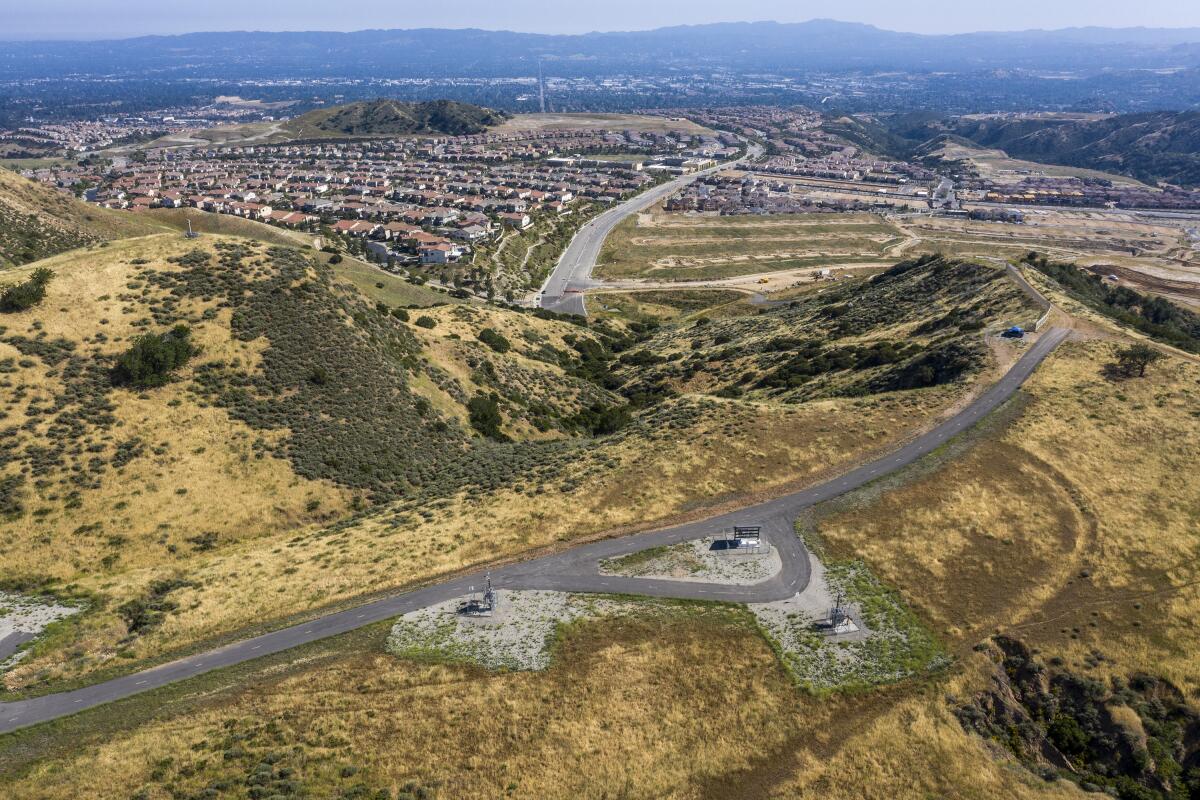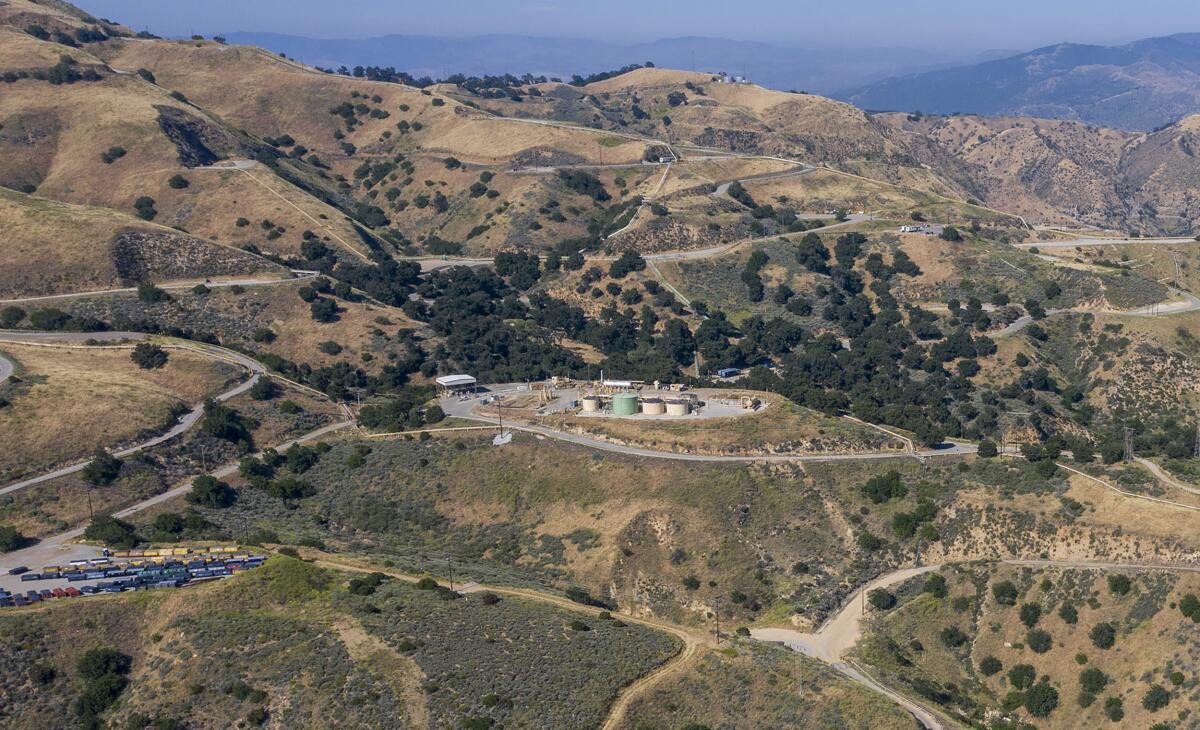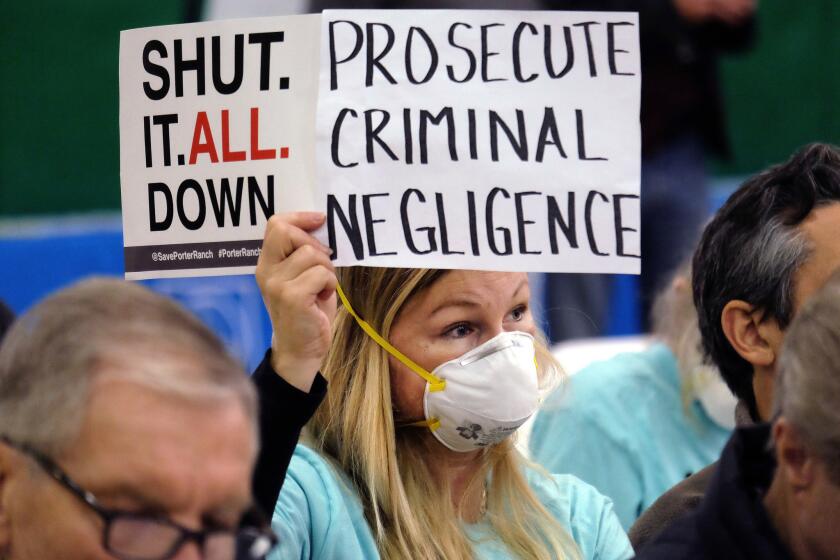SoCalGas ramps up use of Aliso Canyon, site of worst gas leak in U.S. history

- Share via
While campaigning for governor, Gavin Newsom said he was committed to shutting down the Aliso Canyon storage field, the site of a record-setting methane blowout that spewed heat-trapping gases into the atmosphere and sickened nearby residents.
But Southern California Gas Co.’s use of Aliso Canyon to provide natural gas to its customers has only grown during Newsom’s tenure, a new analysis finds.
The environmental group Food and Water Watch, which wants to see Aliso closed, analyzed publicly available data and found that SoCalGas withdrew 20 billion cubic feet of gas from the storage field this winter, primarily to heat homes in the Los Angeles area. That’s up from 14 billion cubic feet in the winter of 2018-19, and just 1 billion cubic feet the winter before that.
The more the gas company uses the storage field, the higher the risk of additional leaks, said Najmedin Meshkati, a USC engineering professor who co-authored a 2017 study examining the causes of the methane blowout.
“There are more chances for human error. There are more chances for equipment failure,” Meshkati said.
Toward a more sustainable California
Get Boiling Point, our newsletter exploring climate change, energy and the environment, and become part of the conversation — and the solution.
You may occasionally receive promotional content from the Los Angeles Times.
The October 2015 leak lasted four months and caused the largest known release of methane — a powerful climate pollutant and the main component of natural gas — in U.S. history. The leak also included small amounts of the cancer-causing chemical benzene and other toxic pollutants, as well as mercaptan, an odorant that gives natural gas its rotten-egg smell. Around 8,000 nearby families fled their homes, many complaining of symptoms including headaches, nosebleeds and nausea.
SoCalGas is still using Aliso far less than before the blowout. And the California Public Utilities Commission is still limiting the amount of gas stored at the facility to less than half what was previously allowed to reduce the risk of another failure.
Gas company officials also say they’ve made significant safety improvements in how they operate the storage field.
“What we’ve done makes Aliso Canyon, and our other storage fields as well, the safest in the state,” Rodger Schwecke, the utility’s senior vice president for gas operations and construction, said in an interview. “Of the 66 wells that we currently have available at Aliso Canyon, we’re going to have 30 or 40 of them reassessed this year — and they are required to be assessed every two years.”
SoCalGas ramped up its use of Aliso this winter with the blessing of the Public Utilities Commission, which loosened restrictions that it first implemented after the blowout. Commission staff had expressed concern that continuing to severely restrict the gas company’s use of the storage field could drive up energy prices statewide and potentially cause supply shortages.
Activists at Food and Water Watch are furious that Newsom’s administration has allowed SoCalGas to rely more heavily on Aliso.
Alex Nagy, the nonprofit group’s California director, said the increased use of Aliso is just one example of Newsom not doing enough to combat climate change and air pollution. She also pointed to the governor’s latest budget proposal, which reneges on his promise to hire more oil and gas regulators, and to the quiet approval of a dozen fracking permits in Kern County last week.
“How willing is Newsom to really take on the fossil fuel industry?” Nagy asked. “He’s not, in my opinion.”

Newsom said last year he wanted to “fast track” the shutdown of Aliso Canyon and get it closed faster than the 10-year timeline proposed by Gov. Jerry Brown’s administration in 2017. In November, Newsom wrote to Marybel Batjer, whom he had recently appointed as Public Utilities Commission president, asking her to “expedite planning” for the facility’s closure.
Newsom said he was concerned the commission’s ongoing efforts to study the feasibility of shutting down Aliso “will not yield the fastest and most workable path toward closure of the facility.” The agency responded by speeding up its slow-moving process, although the earliest closure date it’s studying is 2027, alongside a 2045 shutdown option.
A spokeswoman for the governor declined to comment on the data showing increased use of Aliso.
The storage field’s future is one of several key unanswered questions in California’s ongoing transition from planet-warming fossil fuels to climate-friendly energy sources. The Golden State has nearly eliminated its use of coal, the dirtiest fossil fuel. But natural gas is now the state’s largest electricity source. And millions of people use gas for space heating, water heating and cooking.
Clean energy advocates hope to spur a transition to all-electric homes powered by solar panels and wind turbines. But they’ve faced pushback from SoCalGas, one of the country’s largest gas utilities. To SoCalGas, electrification is an existential threat.
The company has been charging California ratepayers for some contributions to pro-natural gas advocacy groups.
How a pipeline explosion changed everything
Aliso Canyon lies at the heart of a complex network of pipes, poles and wires that power Southern California.
Several aging pipelines carry natural gas toward the Los Angeles Basin, where SoCalGas distributes the fuel to homes and businesses for heating and cooking, and to power plants for electricity generation. The company also stores gas locally at four facilities. The largest is Aliso Canyon, a former oil field north of L.A.’s Porter Ranch neighborhood in the San Fernando Valley.
During the first few years after the blowout, Southern California residents largely got by without Aliso Canyon. Enough gas flowed into Los Angeles through pipelines to fuel electric power plants on hot summer days and to heat homes on cold winter days.
Then everything changed.
In October 2017, a key SoCalGas pipeline exploded in the desert, taking it out of service. The company suddenly had less ability to bring gas into the L.A. Basin, and it wasn’t allowed to draw much from storage at Aliso. Natural gas prices soared, as did electricity prices.

The effects were most dramatic during a summer heat wave. The electric utility Southern California Edison incurred $850 million in unexpected costs, which it’s now passing along to its customers. A cold snap in February 2019 caused energy prices to jump once again and forced some electric power plants to shut down on a handful of days to conserve gas supplies for home heating.
The Public Utilities Commission responded to the volatility by giving SoCalGas greater leeway to withdraw gas from Aliso.
Following conditions laid out by the commission, the company pulled from Aliso on two days last summer and 54 days this winter, Food and Water Watch’s analysis shows. That compared to 38 days the previous winter and six days the winter before that.
Relatively mild weather in winter 2019-20 helped keep energy prices down, as did the long-awaited return of the exploded desert pipeline. But Aliso also played a role in stabilizing prices, according to Public Utilities Commission official Jean Spencer.
Without Aliso, Spencer said in an interview, a lack of sufficient pipeline capacity could have roiled energy markets once again.
“During the high demand days of winter, there’s not a lot of wiggle room between supply and demand” without Aliso, she said.
Two years after methane gas began leaking from Southern California Gas Co.’s Aliso Canyon storage field, one of the company’s key pipelines exploded, starting a fire in the desert and leaving a smoking crater in the ground.
An energy system in flux
Why is there so little wiggle room? In part because some of those pipelines were built six decades ago and aren’t in great shape.
It took SoCalGas two years to bring Line 235 back into service after the October 2017 explosion — a delay the company attributed to corrosive soil, tough working conditions and environmental rules. But critics questioned whether SoCalGas was slow-walking the repairs or not trying hard enough, pointing to examples of other gas utilities fixing broken pipelines much more quickly.
With the pipelines out of service, “you’ve set up a situation where Aliso is more likely to be needed,” said Bill Powers, a San Diego-based energy consultant and consumer advocate who has analyzed Aliso Canyon’s operations for Food and Water Watch.
Critics say SoCalGas has a financial interest in keeping Aliso running. The facility was worth $769 million at the end of 2019, and as long as it remains in use, SoCalGas customers will be on the hook to pay off the company’s investment, plus shareholder profits.

The gas company rejects those criticisms as baseless.
Schwecke said the utility uses Aliso Canyon solely for “the safe and reliable operation of our system.” He also argued that using the storage field in 2020 doesn’t stop policymakers from potentially finding ways to get rid of it years or decades from now.
“Today is about ensuring price stability, price mitigation and reliability. That’s what we use it for today,” he said. “For people to say we’re somehow manipulating the system — I do take offense, because that impugns my integrity as a system operator.”
Line 235 is back in service now — or at least it was until last week, when SoCalGas took it offline again for more inspections and repairs.
And even during the months Line 235 was back online, SoCalGas was flowing less gas through the 1950s-era pipe as a safety precaution, to avoid another explosion. The company is operating a nearby line at reduced pressure for the same reason.
The reductions are unlikely to end unless SoCalGas replaces the aging pipes — a costly and time-consuming prospect.
Regulated utilities like SoCalGas usually love spending money on infrastructure projects because they can recoup their costs from customers, plus profits for shareholders. But at a time when California is trying to transition to cleaner energy, it’s unclear whether the Public Utilities Commission would allow the gas company to charge customers for a massive investment in new pipelines.

The commission faces a “tough dilemma from a policy perspective,” said Simon Baker, deputy director of the agency’s energy division. On the one hand, Californians currently rely on natural gas. On the other hand, climate policies are likely to reduce gas use over time. Gas infrastructure might look like a smart investment today, then quickly become a stranded asset tomorrow.
“Those are the tricky balancing acts that the PUC needs to weigh when these kinds of decisions come before us,” Baker said.
And if pipeline capacity stays limited? Regulators will likely be more susceptible to arguments that Aliso Canyon is still needed.
Does California need Aliso Canyon?
Clean energy advocates would rather see state officials limit the need for all types of fossil fuel infrastructure by encouraging fast, dramatic reductions in natural gas demand.
But they aren’t sure the Public Utilities Commission is up to the task.
The agency has been studying what might happen to energy prices and reliability if Aliso Canyon is shut down — but only under scenarios that assume gas demand stays relatively flat. To clean energy advocates, that’s missing the point, which is that California can minimize or eliminate the need for Aliso — and fight climate change — by enacting policies that reduce the need for gas.
Jim Caldwell, a technical consultant at the Center for Energy Efficiency and Renewable Technologies, said the commission’s ongoing process to study the feasibility of shutting down Aliso “is designed to show that you can’t shut Aliso down, because it doesn’t really look at anything else other than using Aliso.”
“I’m so, so upset with that thing,” he said. “I try not to follow it so closely or my blood pressure goes up.”
Your support helps us deliver the news that matters most. Subscribe to the Los Angeles Times.
Caldwell said the commission should start by assuming there is no Aliso, then figure out how much gas demand would need to drop to make it happen. Then officials could develop policies to phase out natural gas, such as incentives for homeowners to tear out their gas heaters and gas stoves and replace them with heat pumps and induction cooktops powered by electricity.
Commission staffers say they recently launched a new phase of their study, in response to Newsom’s prodding, that will examine options for reducing gas demand — more than three years after lawmakers ordered them to study the closure of Aliso.
But even now, it’s not clear how aggressively the utilities commission might act to support all-electric homes.
“People talk about heat pumps and different things that can be done,” said Spencer, a supervisor in the commission’s gas policy and reliability section. “But how fast can those things happen, particularly given our current economic situation?”

SoCalGas has promoted a different climate solution: replacing some of the fossil gas it delivers to customers with renewable gas, captured from sources such as manure lagoons at dairy farms. There’s already some manure methane flowing through the company’s pipelines, although even gas industry-funded studies suggest a relatively limited role for renewable gas.
Whatever climate strategies California pursues, Porter Ranch residents won’t be satisfied until Aliso Canyon is shut down.
More than 100 people living near the facility sent odor complaints last month to the South Coast Air Quality Management District, many of them fearful there had been another leak. According to Food and Water Watch, residents “reported an increase in burning eyes, heart palpitations, asthma, lung irritation and nose bleeds” — symptoms reminiscent of the 2015 blowout.
Nahal Mogharabi, a spokesman for the Air Quality Management District, said in an email that inspectors didn’t detect any odors and found methane gas to be “within typical background levels.” SoCalGas, too, says it didn’t detect any leaks.











